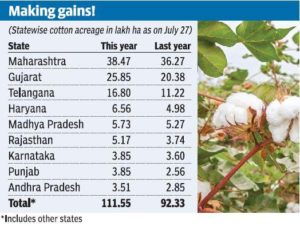
Ahmedabad/Coimbatore August 2:
Notwithstanding crop damage due to floods in Gujarat, the largest cotton producing state, India’s cotton output in the forthcoming 2017-18 season starting October is seen increasing by 10-15 per cent on rise in acreage across the country. Besides, a favourable monsoon in most parts of key growing states such as Maharashtra and Andhra Pradesh, and in North India, is aiding the output.
The cotton trade estimates the output to be higher, by 10-15 per cent, for 2017-18 over last year’s output of 337.25 lakh bales of 170 kg each.
Per the Union Ministry of Agriculture, cotton had been sown on 111.55 lakh hectares till July 28, as against 92.33 lakh hectares witnessed for the same time last year, thereby indicating an increase of close to 21 per cent in the acreage.
Maharashtra has registered kharif cotton sowing of over 38.47 lakh hectares, while in Gujarat the area stood at 25.84 lakh hectares.
However, with the recent flooding in the key growing regions of Gujarat, the authorities expect a damage of about 30 per cent to the crop in the State.
“Trade and government estimates put the acreage growth at about 20 per cent. But we still have monsoon days left and it is unpredictable about the rain fury in other parts. Hence, estimating the output may be speculative,” said Nayan Mirani, President, Cotton Association of India (CAI), the apex trade body.
“However, considering the existing factors and the rainfall, the acreage will comfortably increase by 10-12 per cent and we will have almost equal increase in the production volume too,” he added.
Kharif cotton sowing is completed in most parts of the country and fresh arrivals are likely to begin by mid-September.
J Thulasidharan, Chairman, Confederation of Indian Textile Industry, said the cotton crop situation would be clear only by end August. “The crop needs some rain during August-September, and the pest attack also happens after 140 days of the crop. The changes in the crop will have to be assessed at regular intervals,” he said and added that a small portion of the area (around 6 lakh hectares) stood damaged in Gujarat, but re-sowing has commenced. “We will have to wait and see.”
Source: www.thehindubusinessline.com
